A Thematic Analysis of Inventory Management in Today's Supply Chain
VerifiedAdded on 2023/06/11
|15
|2943
|338
Essay
AI Summary
This essay presents a thematic analysis of contemporary supply chain inventory management, drawing from various literature sources. It emphasizes the importance of inventory management for both public and private sector organizations in optimizing investments and meeting customer demands. The analysis covers key concepts such as inventory planning and balancing demand and supply, highlighting the role of forecasting and point-of-sale (POS) data. The paper underscores the significance of supply chain management in enabling effective inventory control, leading to benefits like balanced inventory, improved turnover, accurate planning, and enhanced customer loyalty. Ultimately, the study concludes that proactive inventory management, supported by efficient supply chain practices, is crucial for cost savings and overall organizational success.
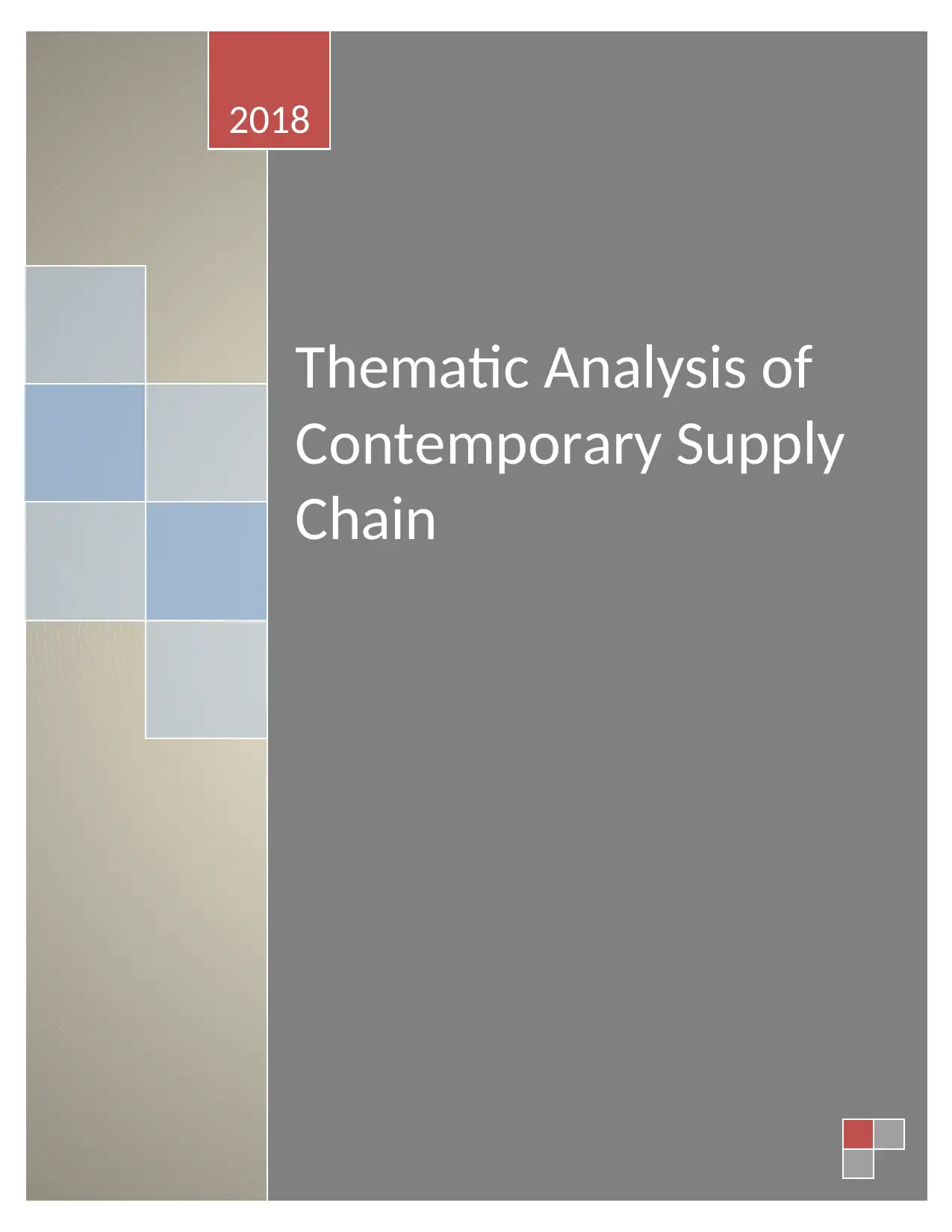
Thematic Analysis of
Contemporary Supply
Chain
2018
Contemporary Supply
Chain
2018
Paraphrase This Document
Need a fresh take? Get an instant paraphrase of this document with our AI Paraphraser
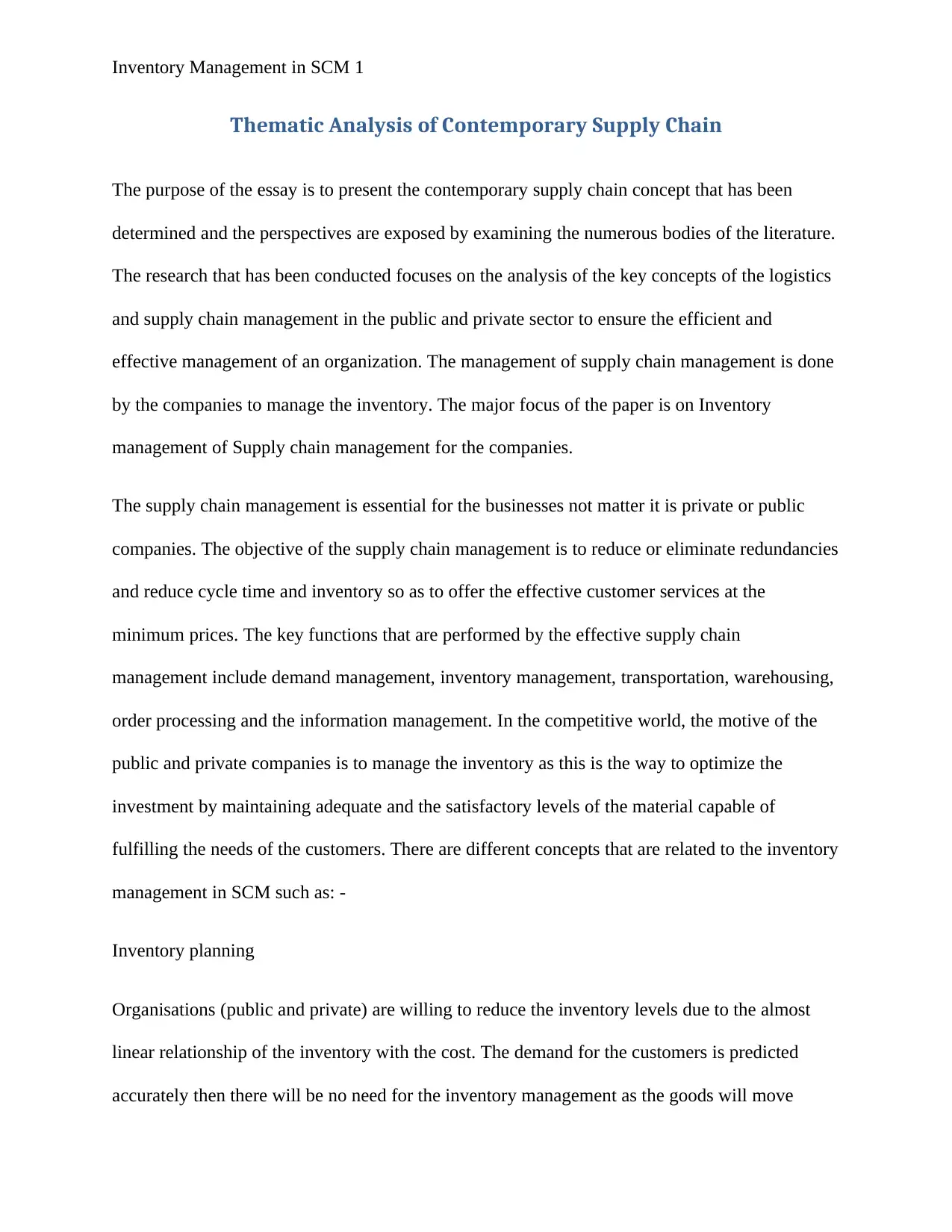
Inventory Management in SCM 1
Thematic Analysis of Contemporary Supply Chain
The purpose of the essay is to present the contemporary supply chain concept that has been
determined and the perspectives are exposed by examining the numerous bodies of the literature.
The research that has been conducted focuses on the analysis of the key concepts of the logistics
and supply chain management in the public and private sector to ensure the efficient and
effective management of an organization. The management of supply chain management is done
by the companies to manage the inventory. The major focus of the paper is on Inventory
management of Supply chain management for the companies.
The supply chain management is essential for the businesses not matter it is private or public
companies. The objective of the supply chain management is to reduce or eliminate redundancies
and reduce cycle time and inventory so as to offer the effective customer services at the
minimum prices. The key functions that are performed by the effective supply chain
management include demand management, inventory management, transportation, warehousing,
order processing and the information management. In the competitive world, the motive of the
public and private companies is to manage the inventory as this is the way to optimize the
investment by maintaining adequate and the satisfactory levels of the material capable of
fulfilling the needs of the customers. There are different concepts that are related to the inventory
management in SCM such as: -
Inventory planning
Organisations (public and private) are willing to reduce the inventory levels due to the almost
linear relationship of the inventory with the cost. The demand for the customers is predicted
accurately then there will be no need for the inventory management as the goods will move
Thematic Analysis of Contemporary Supply Chain
The purpose of the essay is to present the contemporary supply chain concept that has been
determined and the perspectives are exposed by examining the numerous bodies of the literature.
The research that has been conducted focuses on the analysis of the key concepts of the logistics
and supply chain management in the public and private sector to ensure the efficient and
effective management of an organization. The management of supply chain management is done
by the companies to manage the inventory. The major focus of the paper is on Inventory
management of Supply chain management for the companies.
The supply chain management is essential for the businesses not matter it is private or public
companies. The objective of the supply chain management is to reduce or eliminate redundancies
and reduce cycle time and inventory so as to offer the effective customer services at the
minimum prices. The key functions that are performed by the effective supply chain
management include demand management, inventory management, transportation, warehousing,
order processing and the information management. In the competitive world, the motive of the
public and private companies is to manage the inventory as this is the way to optimize the
investment by maintaining adequate and the satisfactory levels of the material capable of
fulfilling the needs of the customers. There are different concepts that are related to the inventory
management in SCM such as: -
Inventory planning
Organisations (public and private) are willing to reduce the inventory levels due to the almost
linear relationship of the inventory with the cost. The demand for the customers is predicted
accurately then there will be no need for the inventory management as the goods will move
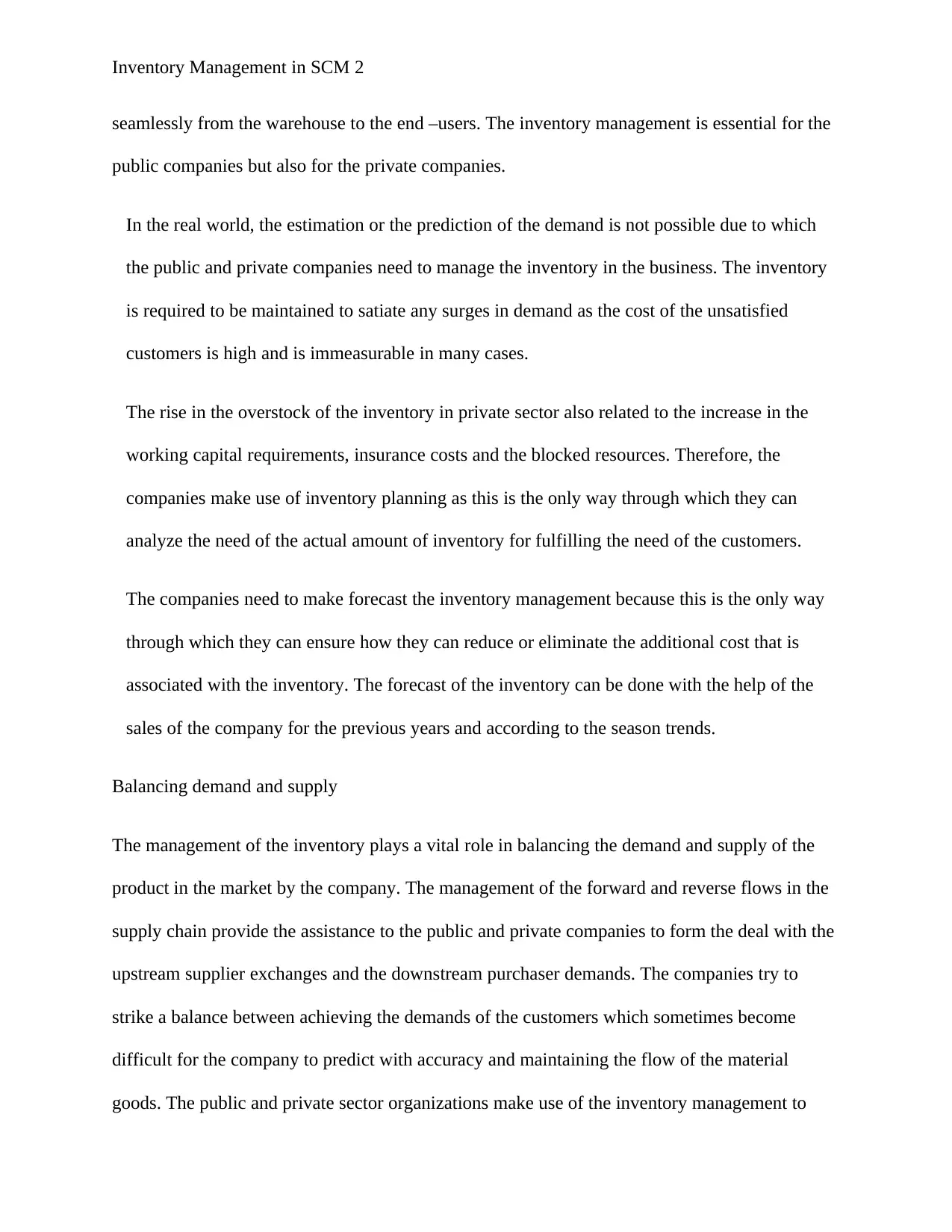
Inventory Management in SCM 2
seamlessly from the warehouse to the end –users. The inventory management is essential for the
public companies but also for the private companies.
In the real world, the estimation or the prediction of the demand is not possible due to which
the public and private companies need to manage the inventory in the business. The inventory
is required to be maintained to satiate any surges in demand as the cost of the unsatisfied
customers is high and is immeasurable in many cases.
The rise in the overstock of the inventory in private sector also related to the increase in the
working capital requirements, insurance costs and the blocked resources. Therefore, the
companies make use of inventory planning as this is the only way through which they can
analyze the need of the actual amount of inventory for fulfilling the need of the customers.
The companies need to make forecast the inventory management because this is the only way
through which they can ensure how they can reduce or eliminate the additional cost that is
associated with the inventory. The forecast of the inventory can be done with the help of the
sales of the company for the previous years and according to the season trends.
Balancing demand and supply
The management of the inventory plays a vital role in balancing the demand and supply of the
product in the market by the company. The management of the forward and reverse flows in the
supply chain provide the assistance to the public and private companies to form the deal with the
upstream supplier exchanges and the downstream purchaser demands. The companies try to
strike a balance between achieving the demands of the customers which sometimes become
difficult for the company to predict with accuracy and maintaining the flow of the material
goods. The public and private sector organizations make use of the inventory management to
seamlessly from the warehouse to the end –users. The inventory management is essential for the
public companies but also for the private companies.
In the real world, the estimation or the prediction of the demand is not possible due to which
the public and private companies need to manage the inventory in the business. The inventory
is required to be maintained to satiate any surges in demand as the cost of the unsatisfied
customers is high and is immeasurable in many cases.
The rise in the overstock of the inventory in private sector also related to the increase in the
working capital requirements, insurance costs and the blocked resources. Therefore, the
companies make use of inventory planning as this is the only way through which they can
analyze the need of the actual amount of inventory for fulfilling the need of the customers.
The companies need to make forecast the inventory management because this is the only way
through which they can ensure how they can reduce or eliminate the additional cost that is
associated with the inventory. The forecast of the inventory can be done with the help of the
sales of the company for the previous years and according to the season trends.
Balancing demand and supply
The management of the inventory plays a vital role in balancing the demand and supply of the
product in the market by the company. The management of the forward and reverse flows in the
supply chain provide the assistance to the public and private companies to form the deal with the
upstream supplier exchanges and the downstream purchaser demands. The companies try to
strike a balance between achieving the demands of the customers which sometimes become
difficult for the company to predict with accuracy and maintaining the flow of the material
goods. The public and private sector organizations make use of the inventory management to
⊘ This is a preview!⊘
Do you want full access?
Subscribe today to unlock all pages.

Trusted by 1+ million students worldwide
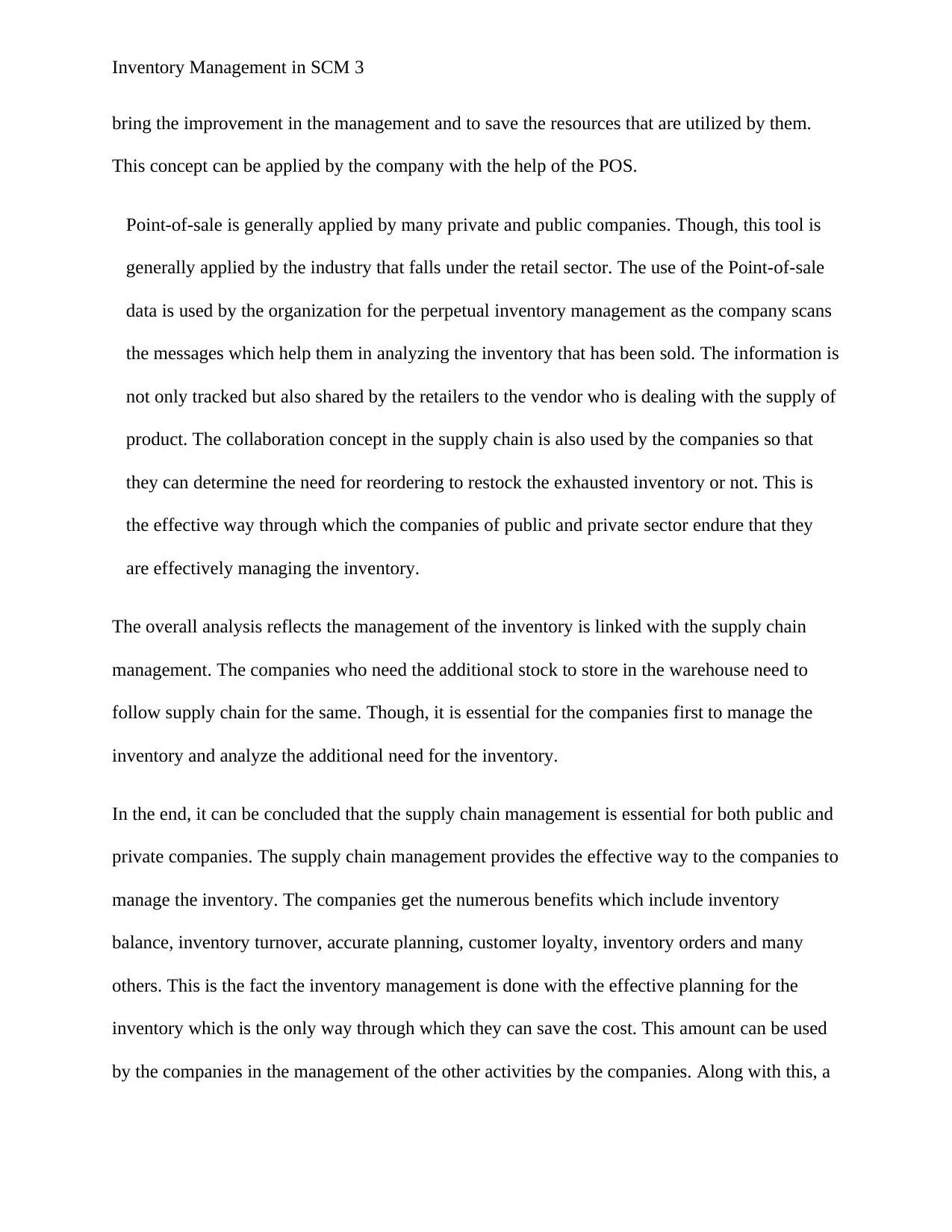
Inventory Management in SCM 3
bring the improvement in the management and to save the resources that are utilized by them.
This concept can be applied by the company with the help of the POS.
Point-of-sale is generally applied by many private and public companies. Though, this tool is
generally applied by the industry that falls under the retail sector. The use of the Point-of-sale
data is used by the organization for the perpetual inventory management as the company scans
the messages which help them in analyzing the inventory that has been sold. The information is
not only tracked but also shared by the retailers to the vendor who is dealing with the supply of
product. The collaboration concept in the supply chain is also used by the companies so that
they can determine the need for reordering to restock the exhausted inventory or not. This is
the effective way through which the companies of public and private sector endure that they
are effectively managing the inventory.
The overall analysis reflects the management of the inventory is linked with the supply chain
management. The companies who need the additional stock to store in the warehouse need to
follow supply chain for the same. Though, it is essential for the companies first to manage the
inventory and analyze the additional need for the inventory.
In the end, it can be concluded that the supply chain management is essential for both public and
private companies. The supply chain management provides the effective way to the companies to
manage the inventory. The companies get the numerous benefits which include inventory
balance, inventory turnover, accurate planning, customer loyalty, inventory orders and many
others. This is the fact the inventory management is done with the effective planning for the
inventory which is the only way through which they can save the cost. This amount can be used
by the companies in the management of the other activities by the companies. Along with this, a
bring the improvement in the management and to save the resources that are utilized by them.
This concept can be applied by the company with the help of the POS.
Point-of-sale is generally applied by many private and public companies. Though, this tool is
generally applied by the industry that falls under the retail sector. The use of the Point-of-sale
data is used by the organization for the perpetual inventory management as the company scans
the messages which help them in analyzing the inventory that has been sold. The information is
not only tracked but also shared by the retailers to the vendor who is dealing with the supply of
product. The collaboration concept in the supply chain is also used by the companies so that
they can determine the need for reordering to restock the exhausted inventory or not. This is
the effective way through which the companies of public and private sector endure that they
are effectively managing the inventory.
The overall analysis reflects the management of the inventory is linked with the supply chain
management. The companies who need the additional stock to store in the warehouse need to
follow supply chain for the same. Though, it is essential for the companies first to manage the
inventory and analyze the additional need for the inventory.
In the end, it can be concluded that the supply chain management is essential for both public and
private companies. The supply chain management provides the effective way to the companies to
manage the inventory. The companies get the numerous benefits which include inventory
balance, inventory turnover, accurate planning, customer loyalty, inventory orders and many
others. This is the fact the inventory management is done with the effective planning for the
inventory which is the only way through which they can save the cost. This amount can be used
by the companies in the management of the other activities by the companies. Along with this, a
Paraphrase This Document
Need a fresh take? Get an instant paraphrase of this document with our AI Paraphraser
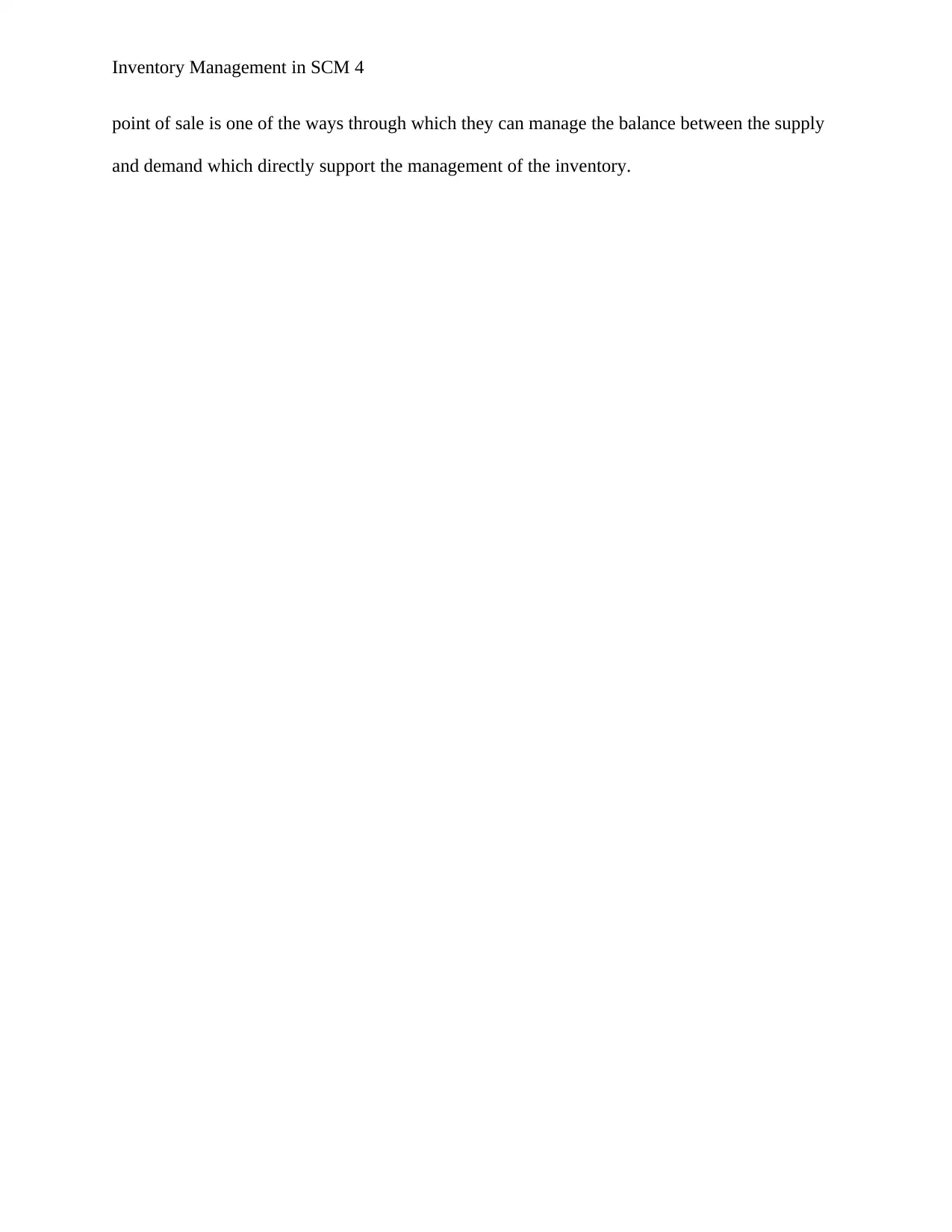
Inventory Management in SCM 4
point of sale is one of the ways through which they can manage the balance between the supply
and demand which directly support the management of the inventory.
point of sale is one of the ways through which they can manage the balance between the supply
and demand which directly support the management of the inventory.
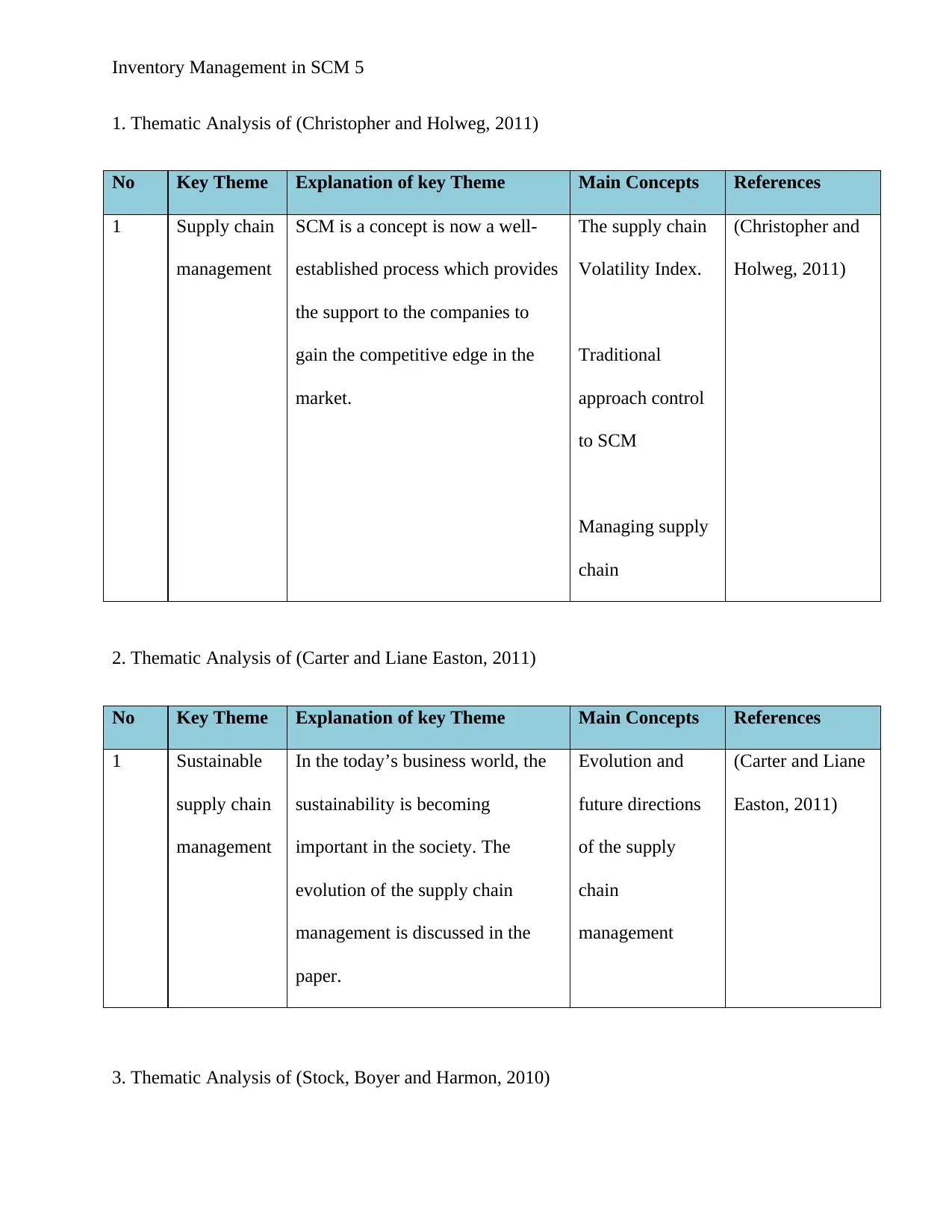
Inventory Management in SCM 5
1. Thematic Analysis of (Christopher and Holweg, 2011)
No Key Theme Explanation of key Theme Main Concepts References
1 Supply chain
management
SCM is a concept is now a well-
established process which provides
the support to the companies to
gain the competitive edge in the
market.
The supply chain
Volatility Index.
Traditional
approach control
to SCM
Managing supply
chain
(Christopher and
Holweg, 2011)
2. Thematic Analysis of (Carter and Liane Easton, 2011)
No Key Theme Explanation of key Theme Main Concepts References
1 Sustainable
supply chain
management
In the today’s business world, the
sustainability is becoming
important in the society. The
evolution of the supply chain
management is discussed in the
paper.
Evolution and
future directions
of the supply
chain
management
(Carter and Liane
Easton, 2011)
3. Thematic Analysis of (Stock, Boyer and Harmon, 2010)
1. Thematic Analysis of (Christopher and Holweg, 2011)
No Key Theme Explanation of key Theme Main Concepts References
1 Supply chain
management
SCM is a concept is now a well-
established process which provides
the support to the companies to
gain the competitive edge in the
market.
The supply chain
Volatility Index.
Traditional
approach control
to SCM
Managing supply
chain
(Christopher and
Holweg, 2011)
2. Thematic Analysis of (Carter and Liane Easton, 2011)
No Key Theme Explanation of key Theme Main Concepts References
1 Sustainable
supply chain
management
In the today’s business world, the
sustainability is becoming
important in the society. The
evolution of the supply chain
management is discussed in the
paper.
Evolution and
future directions
of the supply
chain
management
(Carter and Liane
Easton, 2011)
3. Thematic Analysis of (Stock, Boyer and Harmon, 2010)
⊘ This is a preview!⊘
Do you want full access?
Subscribe today to unlock all pages.

Trusted by 1+ million students worldwide
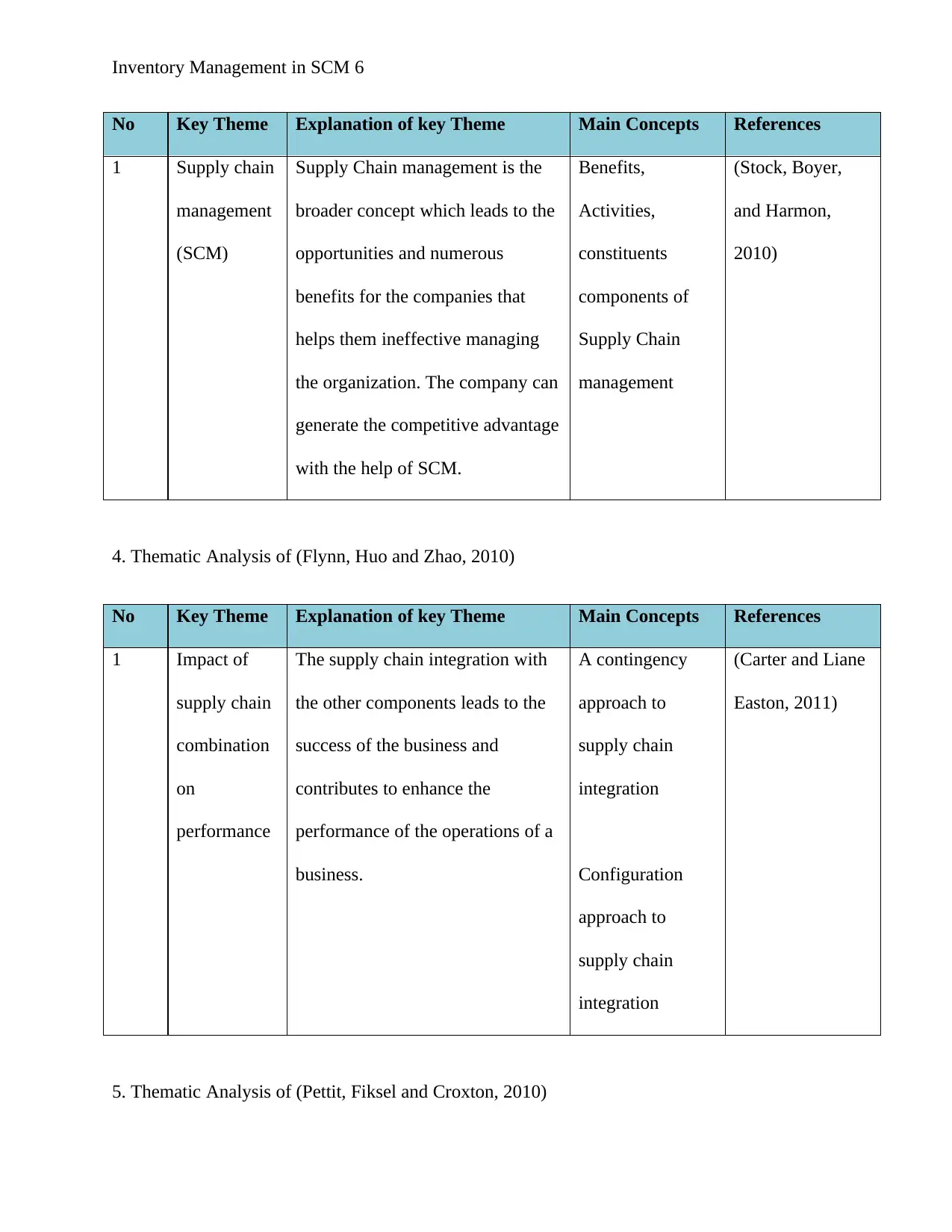
Inventory Management in SCM 6
No Key Theme Explanation of key Theme Main Concepts References
1 Supply chain
management
(SCM)
Supply Chain management is the
broader concept which leads to the
opportunities and numerous
benefits for the companies that
helps them ineffective managing
the organization. The company can
generate the competitive advantage
with the help of SCM.
Benefits,
Activities,
constituents
components of
Supply Chain
management
(Stock, Boyer,
and Harmon,
2010)
4. Thematic Analysis of (Flynn, Huo and Zhao, 2010)
No Key Theme Explanation of key Theme Main Concepts References
1 Impact of
supply chain
combination
on
performance
The supply chain integration with
the other components leads to the
success of the business and
contributes to enhance the
performance of the operations of a
business.
A contingency
approach to
supply chain
integration
Configuration
approach to
supply chain
integration
(Carter and Liane
Easton, 2011)
5. Thematic Analysis of (Pettit, Fiksel and Croxton, 2010)
No Key Theme Explanation of key Theme Main Concepts References
1 Supply chain
management
(SCM)
Supply Chain management is the
broader concept which leads to the
opportunities and numerous
benefits for the companies that
helps them ineffective managing
the organization. The company can
generate the competitive advantage
with the help of SCM.
Benefits,
Activities,
constituents
components of
Supply Chain
management
(Stock, Boyer,
and Harmon,
2010)
4. Thematic Analysis of (Flynn, Huo and Zhao, 2010)
No Key Theme Explanation of key Theme Main Concepts References
1 Impact of
supply chain
combination
on
performance
The supply chain integration with
the other components leads to the
success of the business and
contributes to enhance the
performance of the operations of a
business.
A contingency
approach to
supply chain
integration
Configuration
approach to
supply chain
integration
(Carter and Liane
Easton, 2011)
5. Thematic Analysis of (Pettit, Fiksel and Croxton, 2010)
Paraphrase This Document
Need a fresh take? Get an instant paraphrase of this document with our AI Paraphraser
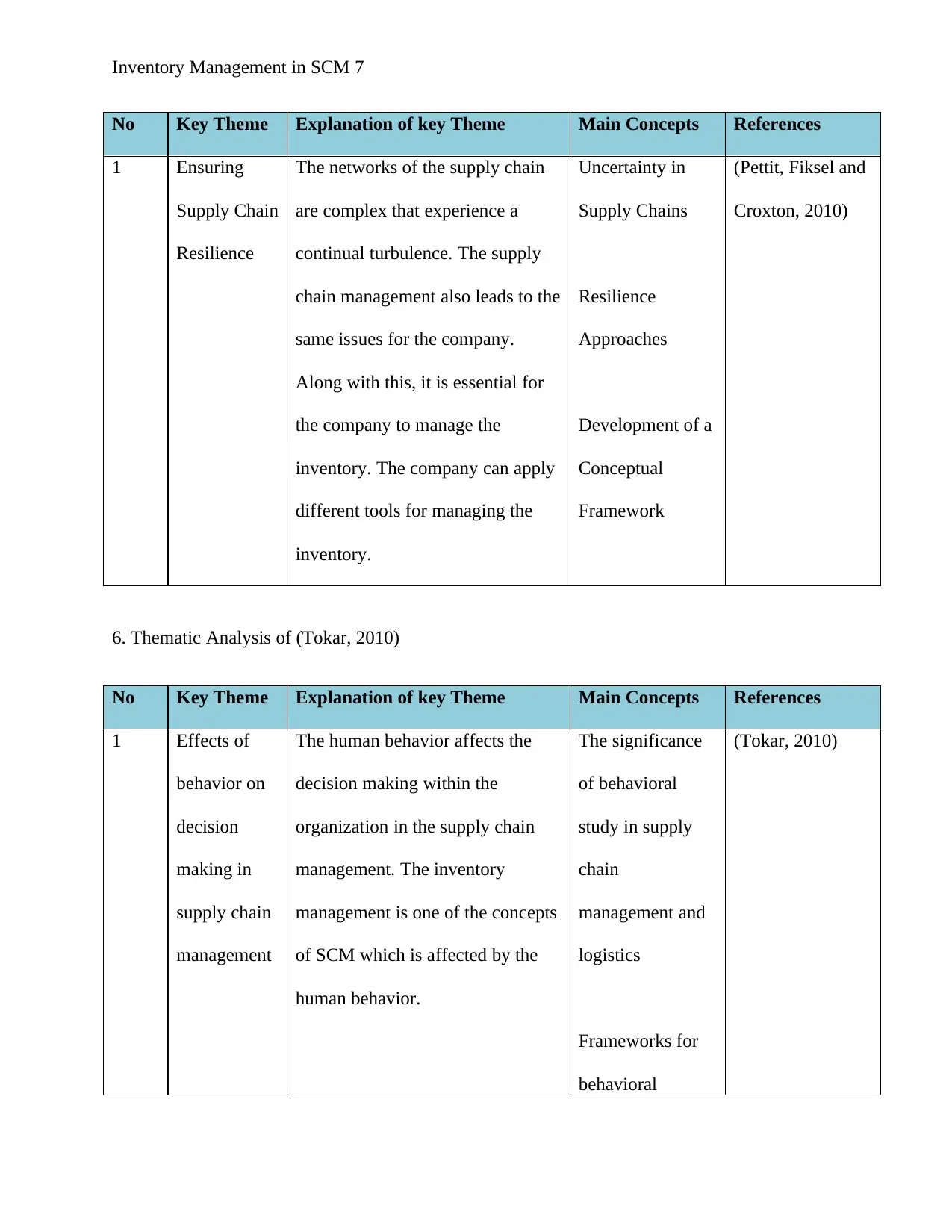
Inventory Management in SCM 7
No Key Theme Explanation of key Theme Main Concepts References
1 Ensuring
Supply Chain
Resilience
The networks of the supply chain
are complex that experience a
continual turbulence. The supply
chain management also leads to the
same issues for the company.
Along with this, it is essential for
the company to manage the
inventory. The company can apply
different tools for managing the
inventory.
Uncertainty in
Supply Chains
Resilience
Approaches
Development of a
Conceptual
Framework
(Pettit, Fiksel and
Croxton, 2010)
6. Thematic Analysis of (Tokar, 2010)
No Key Theme Explanation of key Theme Main Concepts References
1 Effects of
behavior on
decision
making in
supply chain
management
The human behavior affects the
decision making within the
organization in the supply chain
management. The inventory
management is one of the concepts
of SCM which is affected by the
human behavior.
The significance
of behavioral
study in supply
chain
management and
logistics
Frameworks for
behavioral
(Tokar, 2010)
No Key Theme Explanation of key Theme Main Concepts References
1 Ensuring
Supply Chain
Resilience
The networks of the supply chain
are complex that experience a
continual turbulence. The supply
chain management also leads to the
same issues for the company.
Along with this, it is essential for
the company to manage the
inventory. The company can apply
different tools for managing the
inventory.
Uncertainty in
Supply Chains
Resilience
Approaches
Development of a
Conceptual
Framework
(Pettit, Fiksel and
Croxton, 2010)
6. Thematic Analysis of (Tokar, 2010)
No Key Theme Explanation of key Theme Main Concepts References
1 Effects of
behavior on
decision
making in
supply chain
management
The human behavior affects the
decision making within the
organization in the supply chain
management. The inventory
management is one of the concepts
of SCM which is affected by the
human behavior.
The significance
of behavioral
study in supply
chain
management and
logistics
Frameworks for
behavioral
(Tokar, 2010)
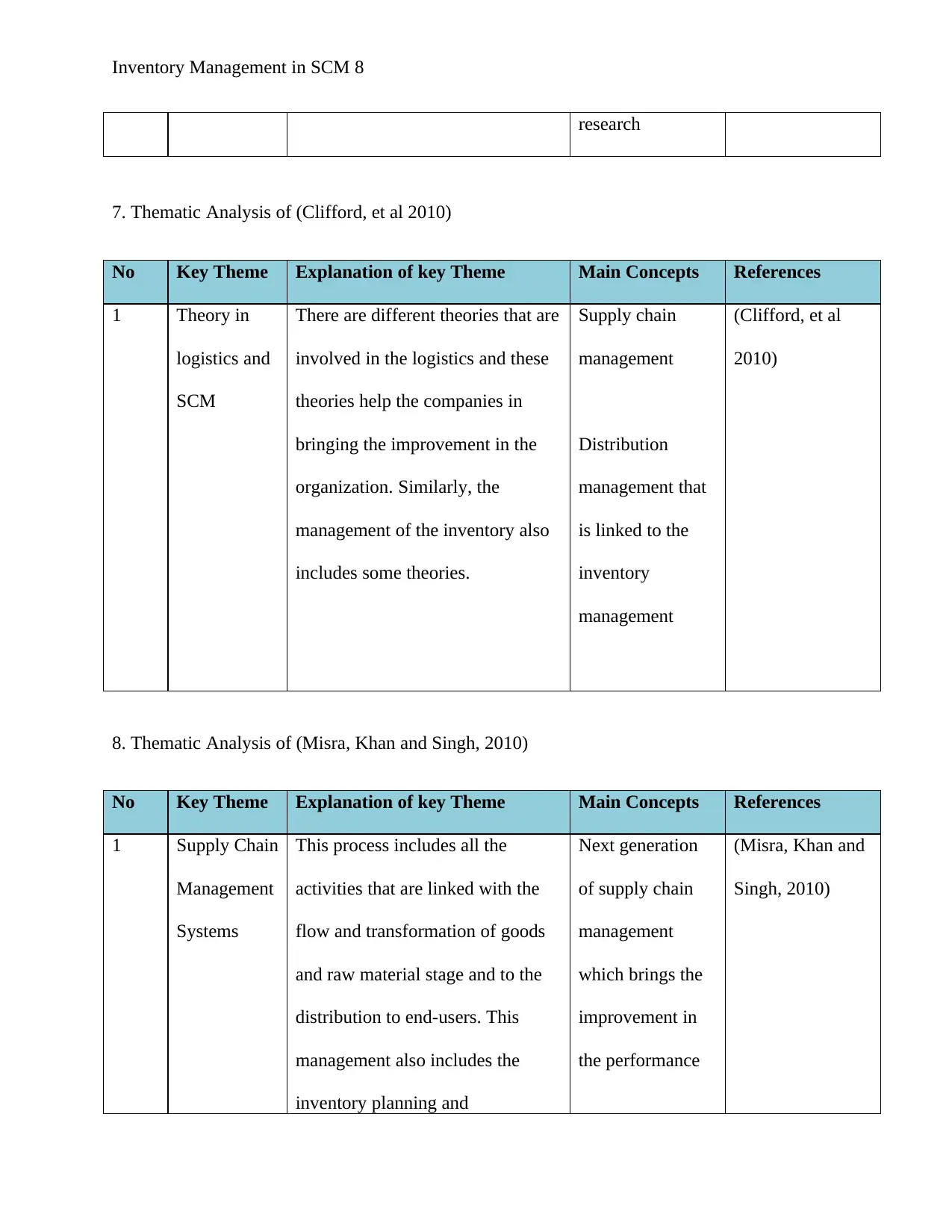
Inventory Management in SCM 8
research
7. Thematic Analysis of (Clifford, et al 2010)
No Key Theme Explanation of key Theme Main Concepts References
1 Theory in
logistics and
SCM
There are different theories that are
involved in the logistics and these
theories help the companies in
bringing the improvement in the
organization. Similarly, the
management of the inventory also
includes some theories.
Supply chain
management
Distribution
management that
is linked to the
inventory
management
(Clifford, et al
2010)
8. Thematic Analysis of (Misra, Khan and Singh, 2010)
No Key Theme Explanation of key Theme Main Concepts References
1 Supply Chain
Management
Systems
This process includes all the
activities that are linked with the
flow and transformation of goods
and raw material stage and to the
distribution to end-users. This
management also includes the
inventory planning and
Next generation
of supply chain
management
which brings the
improvement in
the performance
(Misra, Khan and
Singh, 2010)
research
7. Thematic Analysis of (Clifford, et al 2010)
No Key Theme Explanation of key Theme Main Concepts References
1 Theory in
logistics and
SCM
There are different theories that are
involved in the logistics and these
theories help the companies in
bringing the improvement in the
organization. Similarly, the
management of the inventory also
includes some theories.
Supply chain
management
Distribution
management that
is linked to the
inventory
management
(Clifford, et al
2010)
8. Thematic Analysis of (Misra, Khan and Singh, 2010)
No Key Theme Explanation of key Theme Main Concepts References
1 Supply Chain
Management
Systems
This process includes all the
activities that are linked with the
flow and transformation of goods
and raw material stage and to the
distribution to end-users. This
management also includes the
inventory planning and
Next generation
of supply chain
management
which brings the
improvement in
the performance
(Misra, Khan and
Singh, 2010)
⊘ This is a preview!⊘
Do you want full access?
Subscribe today to unlock all pages.

Trusted by 1+ million students worldwide
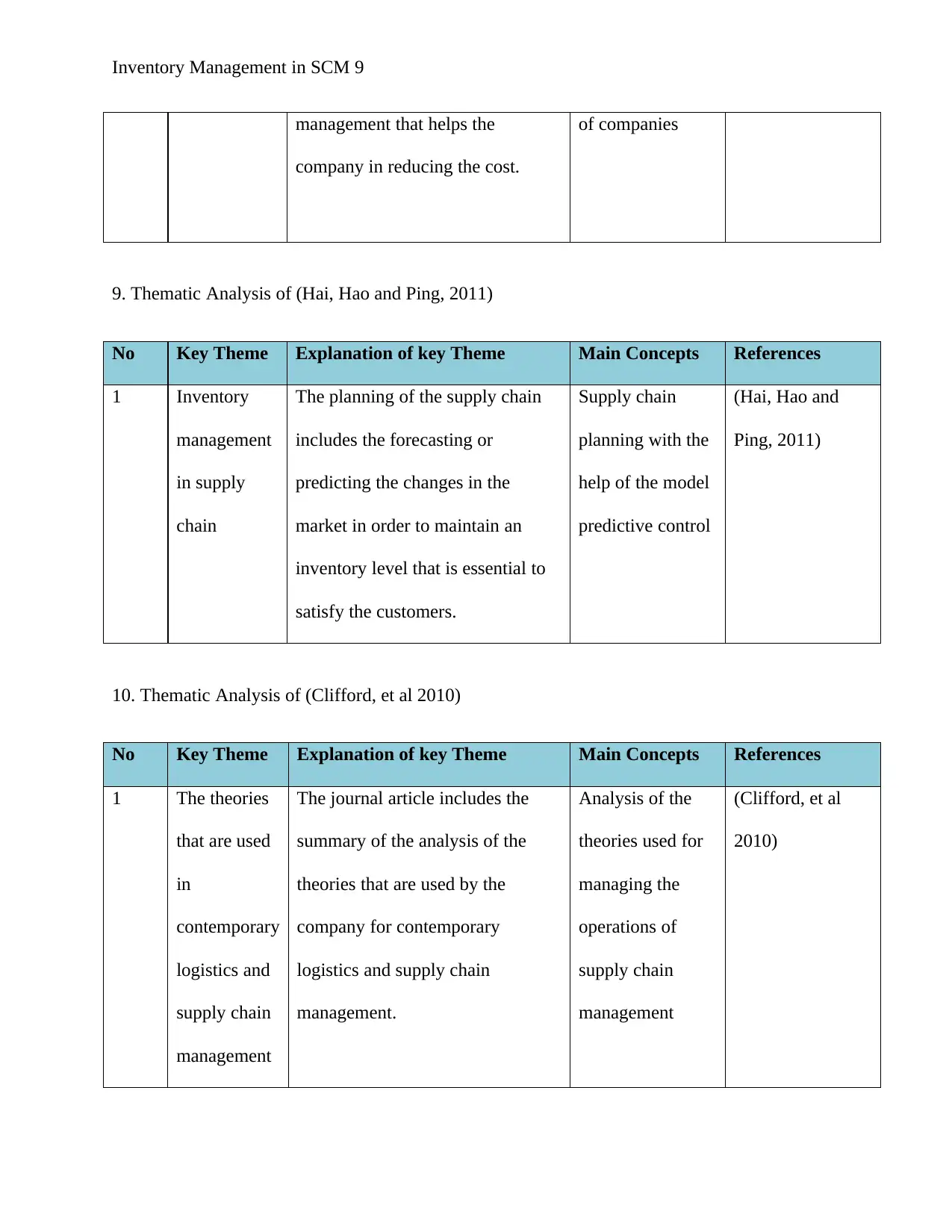
Inventory Management in SCM 9
management that helps the
company in reducing the cost.
of companies
9. Thematic Analysis of (Hai, Hao and Ping, 2011)
No Key Theme Explanation of key Theme Main Concepts References
1 Inventory
management
in supply
chain
The planning of the supply chain
includes the forecasting or
predicting the changes in the
market in order to maintain an
inventory level that is essential to
satisfy the customers.
Supply chain
planning with the
help of the model
predictive control
(Hai, Hao and
Ping, 2011)
10. Thematic Analysis of (Clifford, et al 2010)
No Key Theme Explanation of key Theme Main Concepts References
1 The theories
that are used
in
contemporary
logistics and
supply chain
management
The journal article includes the
summary of the analysis of the
theories that are used by the
company for contemporary
logistics and supply chain
management.
Analysis of the
theories used for
managing the
operations of
supply chain
management
(Clifford, et al
2010)
management that helps the
company in reducing the cost.
of companies
9. Thematic Analysis of (Hai, Hao and Ping, 2011)
No Key Theme Explanation of key Theme Main Concepts References
1 Inventory
management
in supply
chain
The planning of the supply chain
includes the forecasting or
predicting the changes in the
market in order to maintain an
inventory level that is essential to
satisfy the customers.
Supply chain
planning with the
help of the model
predictive control
(Hai, Hao and
Ping, 2011)
10. Thematic Analysis of (Clifford, et al 2010)
No Key Theme Explanation of key Theme Main Concepts References
1 The theories
that are used
in
contemporary
logistics and
supply chain
management
The journal article includes the
summary of the analysis of the
theories that are used by the
company for contemporary
logistics and supply chain
management.
Analysis of the
theories used for
managing the
operations of
supply chain
management
(Clifford, et al
2010)
Paraphrase This Document
Need a fresh take? Get an instant paraphrase of this document with our AI Paraphraser
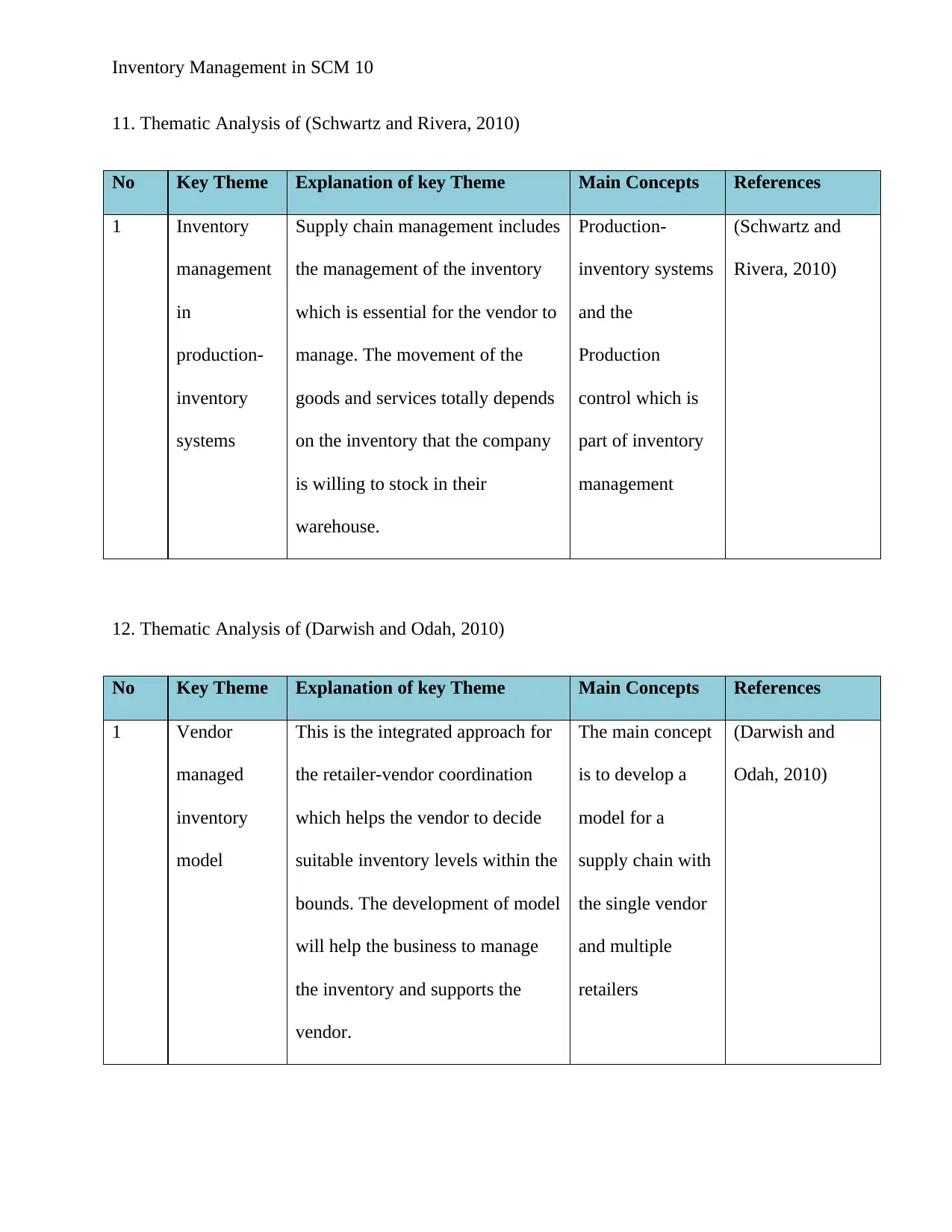
Inventory Management in SCM 10
11. Thematic Analysis of (Schwartz and Rivera, 2010)
No Key Theme Explanation of key Theme Main Concepts References
1 Inventory
management
in
production-
inventory
systems
Supply chain management includes
the management of the inventory
which is essential for the vendor to
manage. The movement of the
goods and services totally depends
on the inventory that the company
is willing to stock in their
warehouse.
Production-
inventory systems
and the
Production
control which is
part of inventory
management
(Schwartz and
Rivera, 2010)
12. Thematic Analysis of (Darwish and Odah, 2010)
No Key Theme Explanation of key Theme Main Concepts References
1 Vendor
managed
inventory
model
This is the integrated approach for
the retailer-vendor coordination
which helps the vendor to decide
suitable inventory levels within the
bounds. The development of model
will help the business to manage
the inventory and supports the
vendor.
The main concept
is to develop a
model for a
supply chain with
the single vendor
and multiple
retailers
(Darwish and
Odah, 2010)
11. Thematic Analysis of (Schwartz and Rivera, 2010)
No Key Theme Explanation of key Theme Main Concepts References
1 Inventory
management
in
production-
inventory
systems
Supply chain management includes
the management of the inventory
which is essential for the vendor to
manage. The movement of the
goods and services totally depends
on the inventory that the company
is willing to stock in their
warehouse.
Production-
inventory systems
and the
Production
control which is
part of inventory
management
(Schwartz and
Rivera, 2010)
12. Thematic Analysis of (Darwish and Odah, 2010)
No Key Theme Explanation of key Theme Main Concepts References
1 Vendor
managed
inventory
model
This is the integrated approach for
the retailer-vendor coordination
which helps the vendor to decide
suitable inventory levels within the
bounds. The development of model
will help the business to manage
the inventory and supports the
vendor.
The main concept
is to develop a
model for a
supply chain with
the single vendor
and multiple
retailers
(Darwish and
Odah, 2010)
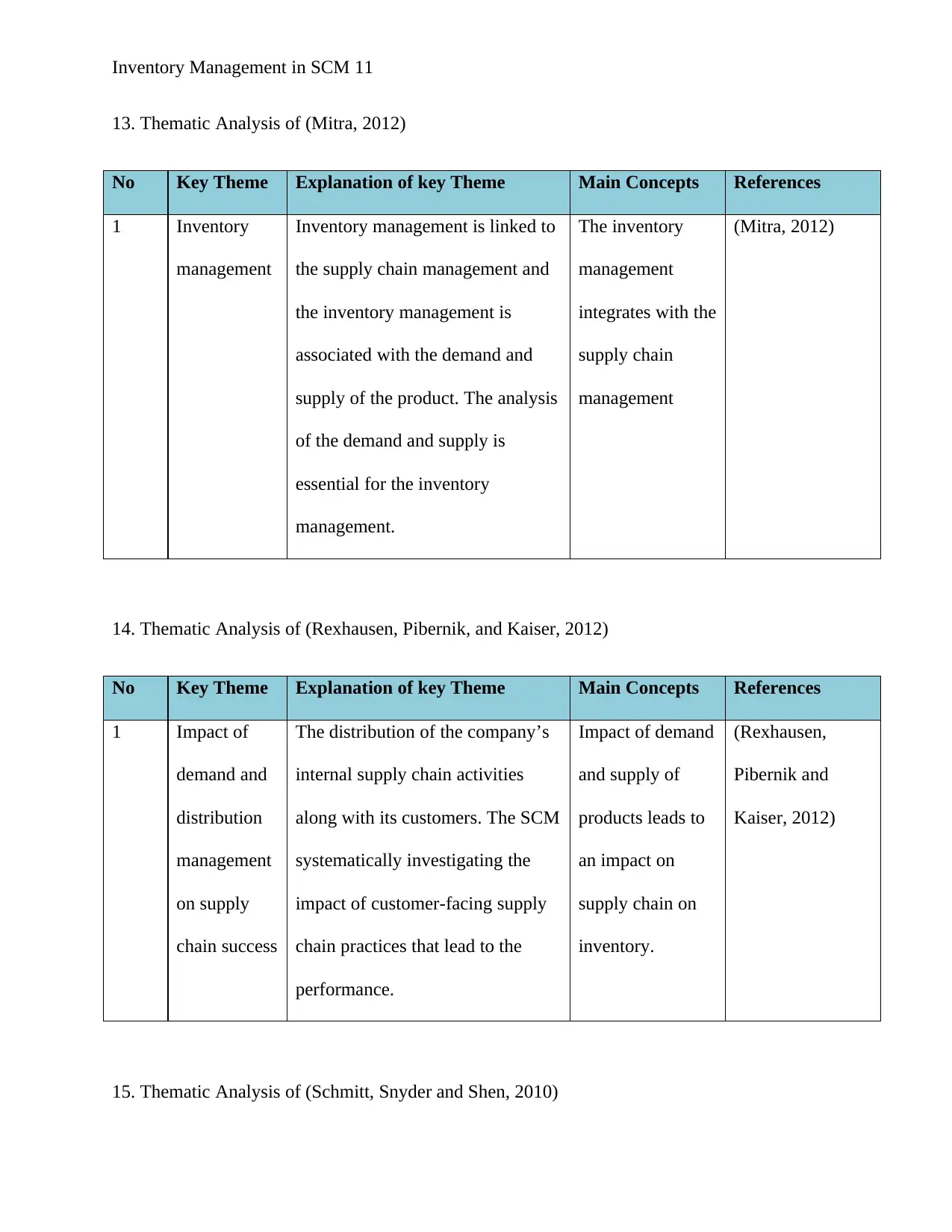
Inventory Management in SCM 11
13. Thematic Analysis of (Mitra, 2012)
No Key Theme Explanation of key Theme Main Concepts References
1 Inventory
management
Inventory management is linked to
the supply chain management and
the inventory management is
associated with the demand and
supply of the product. The analysis
of the demand and supply is
essential for the inventory
management.
The inventory
management
integrates with the
supply chain
management
(Mitra, 2012)
14. Thematic Analysis of (Rexhausen, Pibernik, and Kaiser, 2012)
No Key Theme Explanation of key Theme Main Concepts References
1 Impact of
demand and
distribution
management
on supply
chain success
The distribution of the company’s
internal supply chain activities
along with its customers. The SCM
systematically investigating the
impact of customer-facing supply
chain practices that lead to the
performance.
Impact of demand
and supply of
products leads to
an impact on
supply chain on
inventory.
(Rexhausen,
Pibernik and
Kaiser, 2012)
15. Thematic Analysis of (Schmitt, Snyder and Shen, 2010)
13. Thematic Analysis of (Mitra, 2012)
No Key Theme Explanation of key Theme Main Concepts References
1 Inventory
management
Inventory management is linked to
the supply chain management and
the inventory management is
associated with the demand and
supply of the product. The analysis
of the demand and supply is
essential for the inventory
management.
The inventory
management
integrates with the
supply chain
management
(Mitra, 2012)
14. Thematic Analysis of (Rexhausen, Pibernik, and Kaiser, 2012)
No Key Theme Explanation of key Theme Main Concepts References
1 Impact of
demand and
distribution
management
on supply
chain success
The distribution of the company’s
internal supply chain activities
along with its customers. The SCM
systematically investigating the
impact of customer-facing supply
chain practices that lead to the
performance.
Impact of demand
and supply of
products leads to
an impact on
supply chain on
inventory.
(Rexhausen,
Pibernik and
Kaiser, 2012)
15. Thematic Analysis of (Schmitt, Snyder and Shen, 2010)
⊘ This is a preview!⊘
Do you want full access?
Subscribe today to unlock all pages.

Trusted by 1+ million students worldwide
1 out of 15
Related Documents
Your All-in-One AI-Powered Toolkit for Academic Success.
+13062052269
info@desklib.com
Available 24*7 on WhatsApp / Email
![[object Object]](/_next/static/media/star-bottom.7253800d.svg)
Unlock your academic potential
Copyright © 2020–2025 A2Z Services. All Rights Reserved. Developed and managed by ZUCOL.




